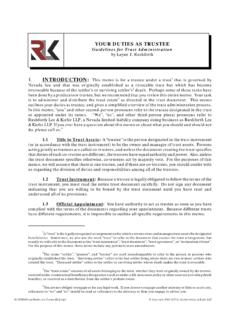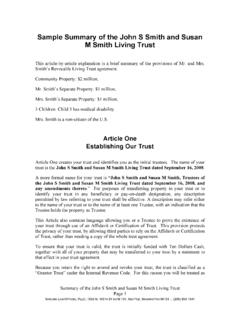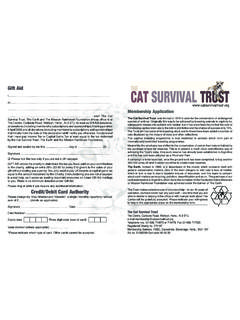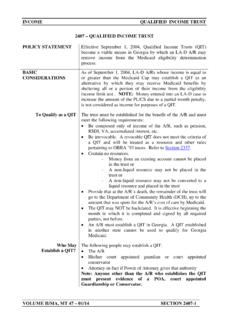Transcription of Irrevocable Life Insurance Trust (ILIT) - The Wealth …
1 THE Wealth COUNSELOR LLC Irrevocable life Insurance Trust (ILIT) What Is the Irrevocable life Insurance Trust ? An Irrevocable Trust is one in which the grantor completely gives up all rights in the property transferred to the Trust , and retains no rights to revoke, terminate or modify the Trust in any material way. When such a Trust holds a life Insurance policy, usually on the grantor's life , it is an Irrevocable life Insurance Trust . If Crummey powers are granted to the beneficiaries, it may also be referred to as a "Crummey Trust " after a famous 1968 court case of the same name. Typically, these trusts are used in estate planning to accomplish four primary objectives: to help meet the liquidity needs of the grantor's estate, to avoid the estate taxation of the death proceeds, to help provide for the income needs of survivors after liquidity costs have been satisfied, and to shelter property from creditors at death.
2 Funding Alternative An Irrevocable life Insurance Trust may be either "funded" or "unfunded." In a funded life Insurance Trust , the grantor not only transfers the life Insurance policy to the Trust , but also transfers other property to the Trust from which the premium payments may be made. The property may be in the form of cash, securities or some other asset. The major drawback of the funded life Insurance Trust is that the Trust income may be taxed to the grantor if it can be used to pay premiums on a policy on the life of the grantor or the spouse. In an unfunded life Insurance Trust , the trustee has no other property in the Trust with which to pay premiums, and is dependent on annual cash gifts from the grantor.
3 The "unfunded" Trust is more commonly used, and we will focus upon it in the remainder of this section. Features of the Irrevocable life Insurance Trust The Irrevocable life Insurance Trust is created during the grantor's life . The beneficiaries of the Trust are often family members of the grantor--spouse, children, grandchildren, spouses of children and grandchildren. The Trust is funded with a life Insurance policy on the grantor. This may be an existing policy which the grantor gifts to the Trust . Unless the policy is paid up, the trustee will have to pay the annual premiums. The trustee could do so with the cash income earned by securities in the Trust (if any), but this would make the Trust income taxable to the grantor.
4 This result also occurs if the policy is on the grantor's spouse. To avoid this problem, the grantor usually makes annual transfers of cash to the Trust so that the trustee can pay the premiums. Of course, these annual transfers are gifts. The gifts would ordinarily be future interests where the Trust beneficiaries cannot begin to "enjoy" the policy as soon as the grantor-insured dies. That means no gift tax annual exclusion is available to shelter the annual cash transfers from the federal gift tax. If the Trust beneficiary can get a distribution of the Insurance proceeds immediately after the insured dies and the proceeds are paid into the Trust , the gift of the policy is a gift of a present interest. Most trusts defer the beneficiary's enjoyment of the proceeds, and thus the gift is of a future interest (unless a Crummey power is used).
5 Irrevocable life Insurance Trust (ILIT), Page 2 The Crummey Power Crummey powers, named after a court case in which the taxpayer's surname was Crummey, are meant to secure the gift tax annual exclusion ($12,000 in 2007) for annual gifts to an Irrevocable life Insurance Trust . These gifts enable the trustee to pay premiums on the policy held in the Trust . A Crummey power gives Trust beneficiaries the power, exercisable annually for a limited period of time, to withdraw the annual cash transfers to the Trust . The beneficiaries are notified when a transfer subject to their powers is made to the Trust . Naturally, one hopes the Trust beneficiaries won't exercise their powers. But the mere fact that they can do so is sufficient to convert the annual transfers to the Trust into present interests that qualify for the gift tax annual exclusion.
6 Crummey powers generally lapse after the specified period expires if they are unexercised, and the trustee is free to use the recently transferred funds for premiums. Example: If there are four beneficiaries with Crummey powers, up to $48,000 of cash transfers could be sheltered in 2007 from the gift tax (or $96,000 if a husband and wife agree to gift-splitting). Notwithstanding the gift tax annual exclusion amount, the Crummey power for each beneficiary is often limited to the greater of: $5,000, or 5 percent of the Trust principal if that is less than $12,000. This is the maximum amount that will not be considered a taxable gift to the other Trust beneficiaries if the holder of the power allows it to lapse unexercised each year.
7 The lapse of a Crummey power is considered a gift to other Trust beneficiaries to the extent that the lapsing power exceeds the greater of $5,000 or 5 percent of the Trust assets subject to the power. If lapses exceed the $5,000/5 percent safe harbor, the Crummey power holders will have to draw upon their gift tax credit amount to shelter the resulting taxable gifts from the gift tax. To avoid this result, Crummey trusts are sometimes drafted to limit the withdrawal right to the lesser of: The beneficiary's proportionate share of additions to the Trust , or The gift tax annual exclusion amount, or The lesser of $5,000 or 5 percent of the Trust corpus. The Trust language should give the beneficiaries a reasonable period of time in which to exercise their powers, say, 30 days.
8 If the Trust says they have until December 31 to exercise their powers, and the grantor makes the cash transfer on December 30, the IRS may view this as a sham. The gift tax annual exclusion (multiplied by the number of beneficiaries with present interests) would be lost. Also, the trustee should give the beneficiaries formal notice that the Trust has received a transfer subject to their Crummey withdrawal powers. The Trust should give the beneficiaries a reasonable period of time in which to exercise their powers, say, 30 days. If the Trust says they have until December 31 to exercise their powers, and the grantor makes the cash transfer on December 30, the IRS may view this as a sham. The gift tax annual exclusion would be lost.
9 Also, the trustee should give the beneficiaries formal notice that the Trust has received a transfer subject to their Crummey withdrawal powers. Irrevocable life Insurance Trust (ILIT), Page 3 Hanging Power The Crummey beneficiary's withdrawal rights could be limited to the lesser of: the beneficiary's proportionate share of the addition, or the amount of the gift tax annual exclusion. Then, to prevent any lapse in excess of $5,000/5% from becoming a taxable gift, the Trust would provide that the excess portion of the annual withdrawal right does not lapse. Rather, it is "suspended" or "hangs" until such time as the grantor discontinues making additions to the Trust . Then, the theory goes, since the $5,000/5% safe harbor is not being used to offset taxable gifts to other beneficiaries, it is available to reduce the accumulated excesses.
10 The result expected is that the accumulated excesses will lapse each year, within the $5,000/5% limit, without gift tax consequences. Once the Insurance death proceeds are paid into the Trust , the hanging power could be exercised by distributing the accumulated excesses. Alternatively, the Trust could remain in effect until the accumulated excesses lapse without resulting in taxable gifts. Unfortunately, the IRS has ruled one hanging power invalid. Where the withdrawal right would not lapse if a taxable gift would be the result, the IRS has said, the power to withdraw beyond the $5,000/5% limit would not be respected. Power of Appointment Another alternative is to give the Trust beneficiaries a testamentary power of appointment over the accumulated excesses.







